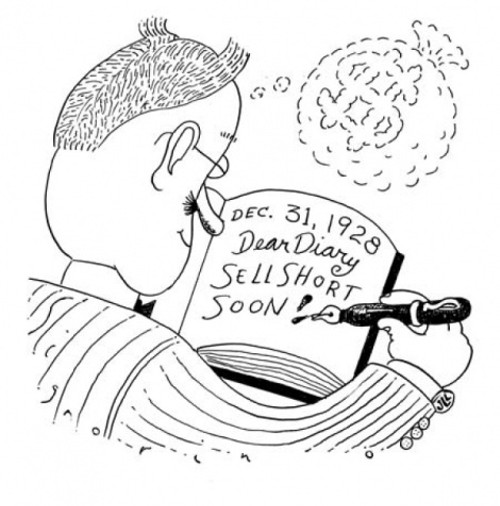Can’t complain, but smart didn’t have much to do with it. Forget to invest in your retirement account: If you don’t bet, you can’t lose. You can’t beat a system like that.
Tales of people making out like bandits just before or during the 1929 stock market crash are relatively rare, possibly because the fortunate few kept it to themselves, given the mood of the times. But we can be certain some did well—a panic sale for one guy often means an easy profit for somebody else. Years ago, I told how Joseph Kennedy, father of John F. et al, made his fortune in part by liquidating stocks right before the crash. Joe wasn’t the only operator out there. Here are the stories of a few more:
The classic way to profit in a declining market is via a short sale—selling stock you’ve borrowed (e.g., from a broker) in hopes the price will drop, enabling you to buy cheaper shares to pay off the loan. One famous character who made money this way in the 1929 crash was speculator Jesse Lauriston Livermore. Starting humbly as a chalkboard boy at Paine Webber, he began looking for patterns in the market and making imaginary bets that earned him fortunes in his diary. By age 16 he was playing with real money as a successful stock trader. Sometimes he was lucky—he made a bundle selling short right before the 1906 San Francisco earthquake, which one assumes he hadn’t foreseen. Other times, he just played his cards right. In 1907 he sold short during a market crash and cleared more than $1 million.
Livermore made his share of mistakes, often losing big in the commodities markets and going bankrupt at least once. But he kept roaring back. He made a few million betting the right way in the World War I bull market of 1916 and claimed he’d made $3 million in 1925 shorting wheat. That was just a warm-up for the real fun during the 1929 crash, when he sold short and made more than $100 million—serious money even now and a monster jackpot then.
If he’d been smart he would have quit right there and lived a life of ease. Uh-uh. He contrived to once again lose most of his money and in 1933 married noted “black widow” Harriet Metz Noble, whose four previous husbands had all committed suicide. Just after Thanksgiving 1940, Livermore joined the club by shooting himself in the head.
Some people made money the old-fashioned way during the crash—i.e., by stealing it. After the initial crisis on Black Thursday, a group of high-powered bankers tried to stabilize the market by using a $130 million pool of funds to buy stocks, sometimes at prices above market value. A member of the group, Albert H. Wiggin, head of Chase National Bank, began short-selling his own portfolio at the same time he was committing his bank’s money to buying. He shorted more than 42,000 shares, making more than $4 million. Because he used a Canadian shell company to buy the stocks, he didn’t even pay taxes on his gains. Though forced to resign in disgrace, Wiggin otherwise went unpunished and got to keep the money, the jerk.
Charles Edwin Mitchell stole less than Wiggin but is remembered as one of the villains of 1929 because he not only took care of himself, he managed to impoverish everybody else. Not long before the crash, he orchestrated a high-pressure campaign to sell $650 million of stock in his National City Bank at an average price of more than $340 per share. By 1933, the stock would be selling for less than a tenth that amount. He then sold 18,300 shares of stock to his wife and later bought it back for a tax loss of nearly $3 million, which meant he paid no income taxes for 1929 despite substantial earnings. Questioned about these transactions by a Senate committee, Mitchell admitted the scam and was charged with tax evasion in 1933. He was acquitted of the criminal counts by a jury, but the government won a civil judgment of more than $1 million in back taxes.
A few people profited in the run-up to the crash because they kept their greed in check. Speculators Bernard Baruch and John Raskob got out of the market in early 1929, sensing trouble ahead. His fortune intact, Baruch remained a respected figure and advisor to presidents till the end of his long life. Raskob later suffered heavy losses when Anaconda Copper shares tanked but remained wealthy enough to develop the Empire State Building, suggesting the truth of the trader’s maxim: There’s a place for bulls and bears but not pigs.
Comments, questions? Take it up with Cecil on the Straight Dope Message Board, StraightDope.com, or write him at the Chicago Reader, 11 E. Illinois, Chicago 60611.
Speaking of...
-
Walk of Shame, The Lego Movie
New DVD/VOD Tuesday, June 17
- Jun 16, 2014
-
Drinking-Class Zero
Following a night of drinking, Wendy Simpson, 25, walked to a McDonald’s restaurant in West Yorkshire, England, where she was told that the counter was closed and only the drive-through was open but that she couldn’t be served
- Jun 16, 2014
-
How to Train Your Dragon 2
Dragon 2 shows DreamWorks is still willing to be daring
- Jun 13, 2014
- More »
More by Cecil Adams
-
This Is the End, My Friend
This week's Straight Dope marks the last appearance of the column as the Teeming Millions have known it for the past 45 years.
- Jul 11, 2018
-
Do Brain Supplements Do Anything?
Brain Drain
- Jul 4, 2018
-
Is flying really worse for the environment than driving?
Planes and Trains
- Jun 27, 2018
- More »




